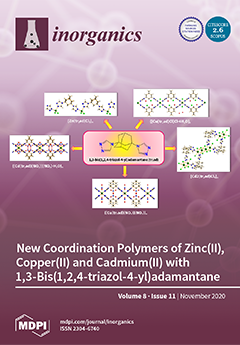The new coordination polymers (CPs) [Zn(tr
2ad)Cl
2]
n, {[Cu(tr
2ad)Cl]Cl∙4H
2O}
n, [Cd
2(tr
2ad)Cl
4]
n, {[Cu(tr
2ad)(NO
3)](NO
3)}
n and {[Cd(tr
2ad)(NO
3)](NO
3)∙H
2O}
n were obtained in the form of air- and moisture-stable microcrystalline powders by the solvothermal reactions of zinc(II), copper(II) and cadmium(II) chlorides or nitrates with the ligand 1,3-bis(1,2,4-triazol-4-yl)adamantane (tr
2ad). Investigation of the thermal behaviour assessed the thermal stability of these CPs, with [Cd
2(tr
2ad)Cl
4]
n starting to decompose only around 365 °C. As retrieved by powder X-ray diffraction, while [Zn(tr
2ad)Cl
2]
n features 1-D chains along which the metal centre shows a tetrahedral geometry and the spacer is exo-bidentate, the other CPs contain 2-D double-layers in which the metal ions possess an octahedral stereochemistry and the linker is exo-tetradentate. A comparative structural analysis involving known coordination compounds containing the tr
2ad ligand enabled us to disclose (i) the versatility of the ligand, as far as the coordination modes are concerned; (ii) the variability in crystal structure dimensionality, ranging from 1-D to 3-D; (iii) the fact that, to the best of our knowledge, [Zn(tr
2ad)Cl
2]
n is the first Zn
II-based CP containing the tr
2ad spacer.
Full article





